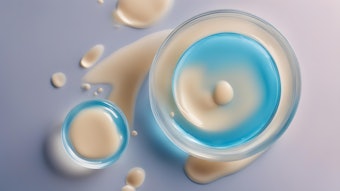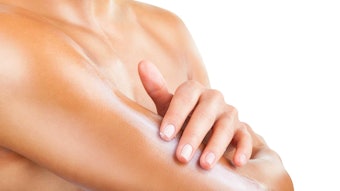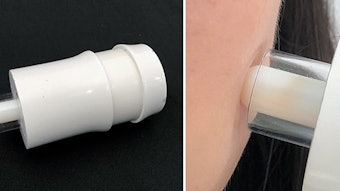The term conditioning is used by consumers rather than scientists, and consequently there is danger in trying to technically define the term. It seems logical, however, to presume that a perceived improvement in hair condition is somehow involved. Accordingly, the ability to mask a rough and degrading surface structure can be perceived as a significant improvement in the condition of hair. As such, surface lubrication represents the primary function of conditioning products, with improved manageability through easier detangling and grooming becoming an additional benefit. Traditional rinse-off conditioner products accomplish this task by depositing a lamellar liquid crystalline structure of water, quaternary amine surfactants and fatty alcohol co-surfactants onto the hair surface. The lubricating performance may be further supplemented by including silicones, which also help mediate a potentially waxy dry-state feel. The deposition of silicones from a shampoo base is the mechanism supporting 2-in-1 shampoo plus conditioner products; however, certain quaternary amine functionalized polymers may also provide lubrication and/or facilitate silicone deposition.
It is helpful to have technical measurements of product performance that provide guidance to the formulation chemist, while also potentially being useful in product marketing. Of course, these instrument-based evaluations contain no information about the aesthetics of formulations, which are considered to be at least equal in consumer importance. Consequently, lubrication at the expense of a particularly greasy, oily or slimy feel would clearly lead to an unacceptable formula.
In addition, the presence of such surface deposits could have a negative effect on other attributes such as weighing down fine, limp hair and reducing the perception of volume and body. Therefore, companies manufacturer products with a spectrum of performance—where lighter-depositing formulas are intended for those with fine, thin hair; while heavier-deposition is desirable for longer, thicker, damaged hair. In short, there are dangers in assigning any “superiority” rank to formulas based on instrumental testing alone. Nevertheless, there is still a strong desire for such measures, particularly at a time when quantitative claims (i.e., 5 times stronger, 4 times smoother, etc.) are popular.
Standard testing protocols are absent from the hair care industry; however, there are a number of methods and approaches that have become widely adopted (although each laboratory likely performs them in a slightly different manner). The most widely utilized approach for evaluating lubrication of hair involves instrumental combing experiments, where the attraction lies with the consumer relevance of the assessment. The methodology involves the use of a mechanical testing device manufactured by companies such as Instron, Dia-Stron and Stable Micro Systems that measure the friction generated between a comb/brush and hair during grooming. Therefore, lubrication is evaluated through a decrease in grooming forces for product-treated hair relative to an unconditioned control. As already mentioned, these experiments can be setup in a variety of ways depending on available resources. However, all approaches should yield quality results after paying due diligence to method validation. Figure 1 shows an experimental test setup where a hair tress is suspended from a load cell that is connected to the cross-head of a tensile testing device. Thus, a hair tress can be pulled through the comb, with an evaluation of the “combing force.”
Materials and Methods
To demonstrate lubrication and differentiate between similar products, there is the need to generate significant grooming forces in the unconditioned state. This can be achieved through a combination of variables including: the size and shape of hair tresses, the condition of the hair and the nature of the comb. Higher combing forces can be generated by using larger and thicker tresses that contain a higher number of fibers, but this strategy is accompanied by an increase in hair costs. Instead, a more practical approach involves the use of chemical treatments to induce a degree of damage (see Chemically Treating Hair for Testing) and subsequently increase the grooming forces. In support of this approach, it should be noted that a high percentage of women regularly utilize a least one such treatment (e.g., bleaching, coloring, perming, relaxing), making chemically treated hair more representative of real life conditions than the pristine hair generally obtained from various suppliers.
The contribution of the comb itself should not be forgotten, where tighter spacing between the teeth will also result in higher combing forces. In summary, the use of chemically damaged hair, in combination with a narrow toothed comb, results in a cost-effective approach for performing this testing.
The largest source of variability associated with virtually all instrumental testing of hair products relates to the treatment procedure, where variation in the way a product is used can outweigh formulation differences. For example, the deposition efficiency of conditioners will be highly dependent on factors such as dosage, residence time on the hair and thoroughness of rinsing. As such, the generation of quality data necessitates standardizing and controlling each of these variables.
Guidance relating to the actual testing procedure can be found in an article by Garcia and Diaz.1 This work outlines how measurements can be performed in both the wet and dry states. An example of typical outputs from both wet and dry state combing experiments is given in Figures 2 and 3.
Both Figure 2 and Figure 3 show the measured force as a function of distance traveled by the crosshead. In wet state experiments, the frictional forces rise initially as the hair engages the comb. These forces then approximate a plateau during the combing process before dropping off to zero as the hair eventually disengages the comb. As shown, multiple combing strokes are collected for each tress. From this output, a number of parameters can then be extracted to quantify the process. Garcia and Diaz advocated the use of the maximum force encountered during the experiment, termed “the peak combing load,” and the average height of the plateau, termed “average combing load.” Another useful measure is the combing energy (or work) represented by the area beneath each curve. In Figure 2, one combing stroke (the first stroke) produced significantly higher combing force than the others. The first stroke is utilizes a higher combing force due to the initial detangling of the tress. Therefore, this first (and possibly even a second) stroke are discarded, with subsequent strokes eventually converging to a yield reproducible combing curves for a given tress.
Dry combing experiments are seen to produce different curve shapes, as grooming forces are low for the majority of the experiment until a spike is produced at the end from detangling the tips. While the presence of lubricating ingredients can again lower frictional forces, products generally show considerably lesser benefit than seen in wet state testing. Namely, dry combing forces are already low, so lubrication does not provide such drastic effects. Consequently, there is less ability to distinguish between the performances of different formulations in the dry state. Furthermore, it is noted that wet state combing and detangling is generally a much greater consumer concern, while also occurring when the hair is in a significantly more vulnerable (weaker) state. Therefore, wet state testing tends to be considerably more prevalent than the dry state equivalent.
Hair is a highly variable substrate and sufficient experimental replicates to ensure a proper statistical analysis should be performed. Experience suggests that testing eight tresses per treatment is generally sufficient.
Case Study
As previously mentioned, the presence of different hair types, combined with a wide variety of consumer habits and practices, dictates the need for products with differing degrees of conditioning. Consumers with long, thick, curly hair often require assistance in enabling them to easily groom and remove tangles. Moreover, the presence of this hair type generally dictates that even high levels of surface deposits will not produce negative “weighing down” issues. These consumers desire strong conditioning formulas, which are often identified by descriptors such as “intensive,” “moisturizing” or “extra moisturizing,” or possibly with a designation for use with “dry, damaged hair.” However, these same products likely provide excessive conditioning to consumers with fine hair, and manufactures also produce lighter conditioners which are identified by proclaiming their ability to “volumize,” or generate “extra body.” Hair care product development scientists require a quick, effective tool to allow them to assess whether prototype formulas have conditioning performance commensurate with their objective. Instrumental combing experiments have the ability to aid in this process.
Figure 4 shows wet combing results for conventional, commercially available, rinse-out conditioner products that were generated with standard methodology. As previously described, sensitivity is improved using bleached hair, which by the current method, yields maximum load combing forces of around 60 g in an unconditioned state. Therefore, all formulations are observed to dramatically lower grooming forces. However, typical “moisturizing” conditioners tend to yield the greatest benefit, due to their high levels of conditioning ingredients. Conversely, typical “bodifying” and “volumizing” variants generally yield somewhat higher combing forces, due to a decreased surface deposition. Lower priced, bargain brand products often attain their price point by using even lower conditioning ingredient levels, while also possibly omitting more expensive ingredients such as silicones. As such, it is common to see such formulas being less effective at lubricating the hair surface. These statements represent generalities, and exceptions can certainly be found, but surveying the wet combing performance associated with a selection of commercial products should yield findings similar to those shown. As such, the lubricating performance of prototype formulas can be assessed and compared to existing benchmarks to provide an indication of whether appropriate conditioning levels are present.
In the mid 1980s, Proctor & Gamble introduced formulations combining shampoo and conditioner benefits (2-in-1s) onto the market under the Pert Plus brand. These products deposit high molecular weight silicone oil onto the hair, which also results in a degree of lubrication but at a lesser level than conventional conditioner products. The extent of this lubrication and the conditioning performance depends on the amount of silicone oil deposited on the hair by a given formulation. The contributing factors to this deposition are complex and involve variables such as composition of the surfactant base, silicone oil droplet size and possibly the presence of deposition-enhancing polymers with differing structures. As such, quantification of silicone deposition levels with techniques such a Inductively Coupled Plasma Optical Emission Spectroscopy (ICP-OES) or X-ray Fluorescence (XRF) are common. Once again, manufacturers produce variants within a given brand that impart different levels of conditioning, with this being achieved by varying silicone deposition levels. Figure 5 shows wet combing results for two commercially available 2-in-1 products. Shampoo 1 was found to deposit 140 ppm Si/g hair, while Shampoo 2 deposits 600 ppm/Si/g hair. As anticipated, significantly more surface lubrication is attained when using Shampoo 2.
Therefore, the formlation chemist has the ability to determine whether prototype formulations approximate technical performance levels that are commensurate with their target and benchmarks.
Conclusion
While surface lubrication is the primary technical function of conditioning treatments, it is not a term used by consumers. Instead, the result of this benefit is often noted by consumers in terms of smoothness and softness, while also being behind other attributes such as improved manageability due to easier grooming and detangling, protection due to reduced abrasion of the hair surface, and breakage reduction due to fewer snags and tangles. Continuing in the consumer vernacular, if the condition of the hair is improved, the perception may be that some form of “repair” has taken place. If the consumer believes that negative feel qualities are a consequence of “dryness,” then the perception may be that “moisturization” has occurred.
Technically, the products have not altered the physical structure of hair in any way, nor have they had any effect on the water content, yet consumer perception dictates the continued use of this language in marketing these products. As a result, instrumental wet combing experiments are frequently used to validate a variety of product claims, potentially making them the most widely used of all in vitro screening tests in the hair care industry.
Reference
Send e-mail to [email protected].
1. ML Garcia and J Diaz, Combability Measurements on Hair, J Cosmet Sci 27 379–398 (1976)









